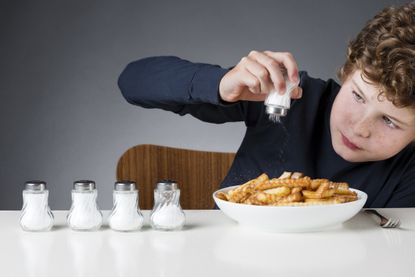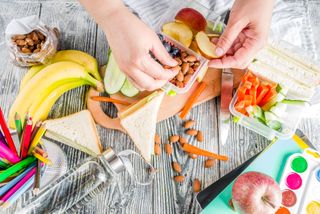How much salt is safe for children?
Too much salt has been associated with several health conditions


Salt is a key mineral that plays an important role in our overall health supporting vital areas such as muscle and nerve function. But, how much salt is safe for children - and, how can you reduce salt intake for children and babies?
Too much salt has been associated with increased risk of conditions such as heart disease and stroke as well as putting additional pressure on our kidneys, the organ that filters and cleans our blood. And while we may be aware of salt limits for adults, it’s equally as important to understand the maximum amount of salt our little ones should be consuming as part of a healthy balanced diet.
What is the recommended amount of salt for babies and children?
Babies and children need very little salt in their diet, particularly because babies’ kidneys aren’t yet fully developed. Below are recommended amounts for each age group. Bear in mind, One teaspoon of table salt equals to 5.69 grams.
- Babies under 1 year - less than 1g of salt a day
- 1 to 3 years – 2g salt a day (0.8g sodium)
- 4 to 6 years – 3g salt a day (1.2g sodium)
- 7 to 10 years – 5g salt a day (2g sodium)
- 11 years and over – 6g salt a day (2.4g sodium)
What is the difference between sodium and salt?
Salt is made up of around 40 per cent sodium while the remaining 60 per cent is made up of chloride. Both of these chemical elements play a role in balancing fluid in our cells, which in turn impacts our blood pressure. As an example excess amounts of sodium can lead to an increase in blood pressure.
To convert salt to sodium you divide it by 2.5 and vice versa. So, as an example 2.5g salt = 1g sodium.
Breastmilk and salt

Estimates from one university study* suggests that breast milk has a lower sodium content than cow’s milk. But for those mothers unable to breastfeed or who opt not to for other reasons, the good news is that some varieties of formula appear to have a similar sodium content, as outlined below:
- Breastmilk: 15mg (0.015g) per 100ml
- Formula: 15-30 mg (0.015g - 0.03g) per 100ml
- Cow’s milk: 55mg (0.055g) per 100ml
N.B: Divide by 1,000 to convert milligrams (mg) into grams (g).
GoodtoKnow Newsletter
Parenting advice, hot topics, best buys and family finance tips delivered straight to your inbox.
Weaning and salt
Babies generally begin weaning from six months onwards, with solid foods slowly being introduced to their diets. No salt should be added to weaning foods. Luckily the novelty of new tastes and textures should stimulate babies’ tastebuds, without the need to get the salt-shaker out.
Traffic light labelling for salt
The traffic light system is a useful quick look guide to various elements of our nutrition, including salt, particularly when it comes to choosing ready meals or pre-packaged food for children. Green indicates the healthier of the three choices listed below.
- Green: 0g - 0.3g Salt/0g -0.1g Sodium
- Amber: 0.3g - 1.5g Salt/0.1g - 0.6g Sodium
- Red: More than 1.5g Salt/ More than 0.6g Sodium
MORE: The hidden sugar in the everyday foods we feed our family
Which children’s foods are higher in salt?
In general processed food tends to have a higher salt content than meals made from scratch.
As an example a survey conducted by campaign group Action for Salt found that 65 cereal products aimed at children had an amber labels, containing more salt than a 100g bag of salted crisps. In another survey, the group analysed 351 children’s meals from 26 outlets including popular high street restaurants, pubs and fast food chains and found that 41 per cent contained more than 1.8g salt per serving. This would be equivalent to red labelling.
High salt foods to be aware of include:
- Cheese (high salt varieties include imported blue cheeses such as Roquefort, feta and halloumi)
- Processed meats such as bacon, ham, salami and sausages
- Table sauces such as mayonnaise and ketchup
- Crisps
- Some brands of bread (check the label)

Which children’s foods are lower in salt?
Alongside fresh fruit, vegetables, pulses (if using tinned ensure no added salt) and plain grains such as pasta, rice and cous cous there are a number of lower salt foods to choose from including the below:
- Fresh meat, poultry and fish (if tinned make sure this is in water)
- Unsalted snacks e.g. popcorn
- Lower salt cheeses including cottage cheese, Emmental, ricotta and mozzarella
- Breakfast cereals (with no added salt, such as Weetabix) and porridge oats
- Homemade bread, soups and sauces
- Yogurt
Simple swaps to reduce children’s salt intake
- Use herbs, spices and flavourings such as chilli, lemon, garlic and pepper in place of salt where possible
- Create a healthier lunch box using some of the lower salt foods listed above
- Limit the amount of battered/breaded food to twice a week
- Choose lower salt varieties of soy sauce, stock cubes and gravy as well as storecupboard staples such as baked beans
* Avon Longitudinal Study of Parents and Children

Jessica is a freelance food writer, stylist and recipe tester. She previously worked as Senior Food Writer at Future. While at Future Jessica wrote food and drink-related news stories and features, curated product pages, reviewed equipment, and developed recipes that she then styled on food shoots. She is an enthusiastic, self-taught cook who adores eating out and sharing great food and drink with friends and family. She has completed the Level 1 Associate course at the Academy of Cheese and is continually building on her knowledge of beers, wines, and spirits.
-
 The 3 stages of play every parent needs to know to save their sanity (and you're probably nailing #2)
The 3 stages of play every parent needs to know to save their sanity (and you're probably nailing #2)By Dr Amanda Gummer Published
-
 Top 20 rare baby names for 2024 revealed, with some celestial and regal entries
Top 20 rare baby names for 2024 revealed, with some celestial and regal entriesParents looking for rare baby names need look no further - these 20 monikers fit the bill for being unique while remaining suitably understated.
By Lucy Wigley Published